Overwintering plants is a great way to enjoy your favorites year after year, without having to spend a dime. In this post, I’ll show you all you need to know about how to keep plants over winter, using a variety of different methods and techniques.
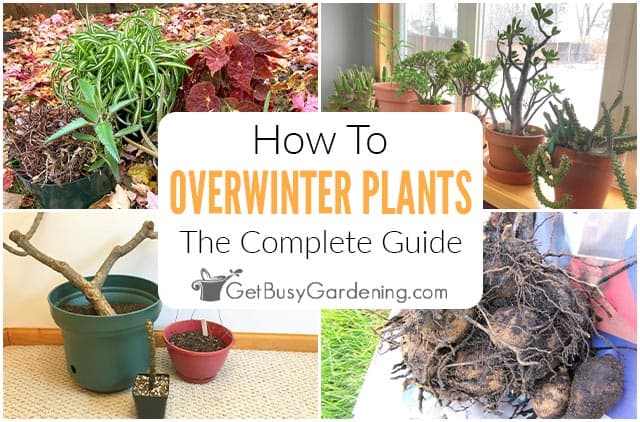
If you’ve ever thought about how you could keep your favorite plants over winter, then you’re in the right place.
Overwintering plants indoors is easier than you think. And you don’t need tons of space or a big heated greenhouse to protect them from the cold.
I don’t know about you, but I used to spend tons of money at the garden center every spring to fill my summer planters and garden beds.
When fall would roll around, I was always so sad to watch them all die. Only to have to pony up the cash to buy them again the following spring. It seemed like such a waste!
If you’re in the same boat, you will be pleasantly surprised to learn that many of your favorites will grow again year after year, without having to spend all of that money.
In this detailed guide, I will show you all you need to know about wintering plants indoors so that you can save yourself some cash, and keep your favorites for years to come.
What Is Overwintering Plants?
The term “overwintering plants” means exactly what it sounds like. Basically, it means that you somehow protect non-hardy varieties from dying when the weather turns cold in the fall.
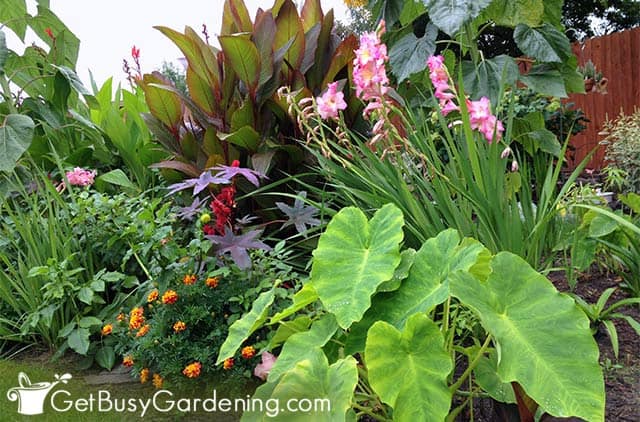
Benefits Of Overwintering Plants
In my opinion, the biggest benefit of overwintering plants is saving money. I used to buy tons of new varieties every spring, only to let them all die in the fall. It always seemed like such a waste.
That’s why I started experimenting with the different ways I could keep them alive for more than one growing season.
For other people, it’s more about saving rare or uncommon specimens. Or, simply enjoying the challenge of pushing the limits of their growing zone, and experimenting to see how far they can take it.
When To Move Plants Indoors For Winter
The timing of when to bring them indoors depends on the method you want to use for overwintering each type of plant.
If you want to keep them growing through the winter, then you should move them indoors in late summer, before the weather starts to cool down.
Otherwise, in general, you can usually leave them outside until they naturally go dormant. I’ll discuss more about the exact timing for each method below.
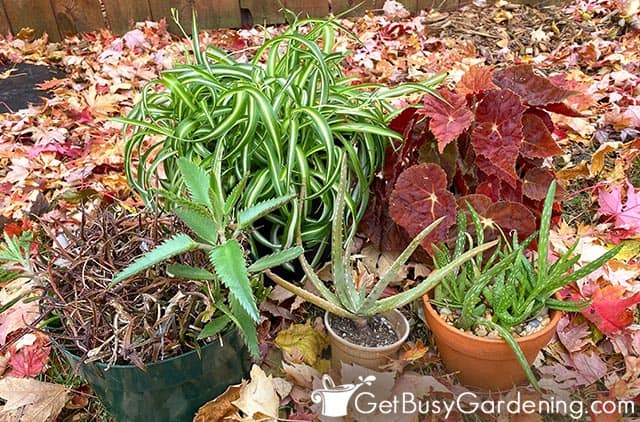
How To Overwinter Plants Indoors
Overwintering plants is definitely not a one-size-fits-all strategy. There are several different ways you can do it.
You might find that one technique works better for some than it does for others.
The best way to figure it out is to experiment to see what works best for you, and for your plant.
Here’s a list of the most common methods of overwintering. I will discuss each one in detail below.
- Forcing the plant to go dormant
- Digging and storing the bulbs/tubers
- Wintering it inside the house as a live plant
- Overwintering cuttings indoors
- Keeping them in an unheated, cold space
1. Overwintering Dormant Plants
There are several types of plants that you can force to go dormant, and then overwinter them indoors right in their pots. Here are a few that I’ve had the most success with…
To trigger a plant to go dormant, move it to a cool, dark room before frost in the fall, and stop watering it.
Most dormant plants will drop all of their leaves or die back to the soil level, which is totally normal.
Check on it every few weeks, and water it sparingly through the winter. Keep it on the dry side, but never let the soil become bone dry.
Then in late winter, slowly wake it up by moving it into a sunny room, and start watering again.
Once you see new growth, move it to a sunny window until it’s warm enough to put back outside.
Learn exactly how to bring a plant out of dormancy in the spring (without killing it).
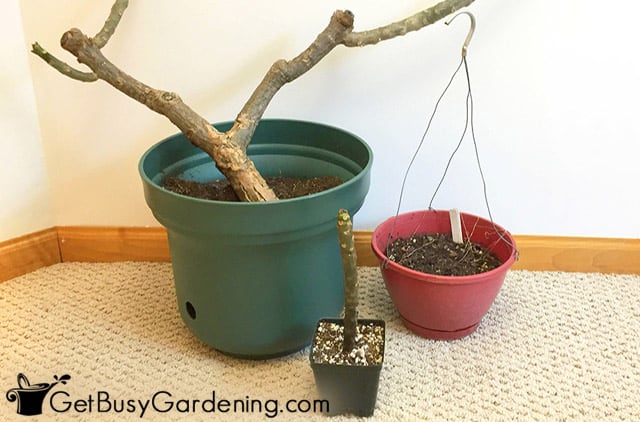
2. Storing Bulbs & Tubers
Some of your favorite summer annuals have bulbs (also called corms or tubers) which you can dig up and bring inside. I have several in my collection, including…
- Caladium
- Canna lilies
- Dahlias
- Elephant ears
- Tuberous begonias
This is one of the easiest and most common methods for overwintering plants. After frost kills the foliage, dig the bulbs out of the dirt, and cut off all the leaves.
Allow them to cure (dry out) for several days in a dry location. Then wrap them loosely in newspaper, and put them into cardboard boxes.
Instead of newspaper, you can pack them in peat moss, sawdust, or coco coir. Store the boxes on a shelf in the basement, or other cool (above freezing), dry location until spring.
Read all about how to store bulbs for the winter here.
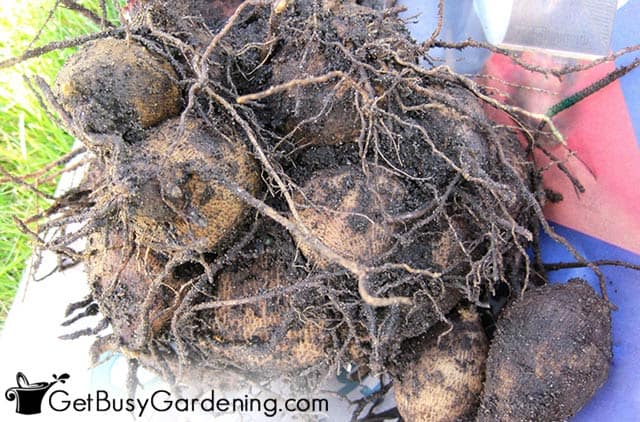
3. Wintering Live Plants Indoors
Another common method is to winter live plants inside of your house. This is easier for some varieties than it is for others.
The main concerns with overwintering live plants are space, light, and bugs.
But, if you have a green thumb, and plenty of room, it’s really nice to fill your home with life to help get you through the long, cold months!
If you want to give this a try, then plan to move them inside before the temps drop below 50F outside.
Otherwise, if it gets too cool, it could trigger dormancy, or cause too much shock for the plant to survive.
To mitigate the risk of bug infestations, make sure to debug your plants before bringing them inside.
If your house doesn’t have a lot of natural sun, get a few grow lights to supplement.
You can find out everything you need to know about how to keep houseplants alive in winter here.
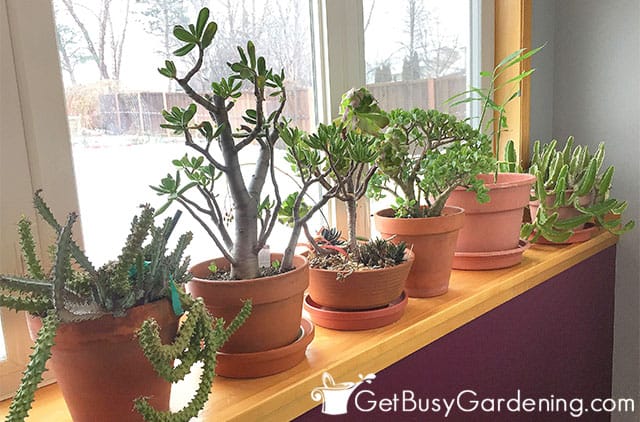
4. Overwintering Plant Cuttings
Some plants get so huge during the summer, that it’s too hard to move them inside for the winter.
But don’t despair, many times you can bring cuttings indoors instead. I do this every year with a few of my favorites…
- Coleus
- Fibrous begonias
- Sweet potato vine
- Tradescantia
If you want to try this method of overwintering plants, than you must take the cuttings before cold weather hits your area in the fall.
Otherwise, they might not survive the shock of being moved indoors. Also, if they have already been damaged by frost, they may not take root.
Find out more about rooting cuttings in my complete guide for how to propagate plants.
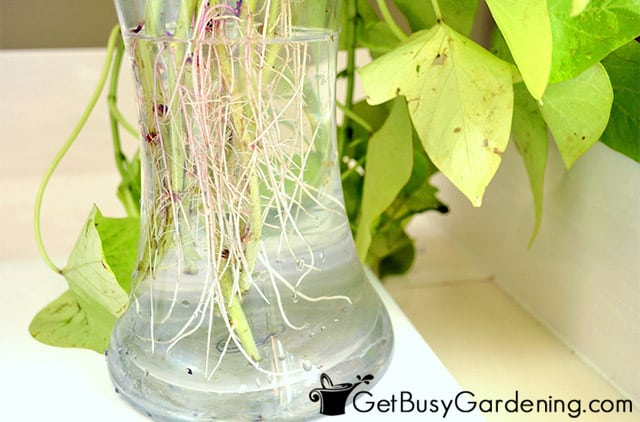
5. Overwintering Perennials In Containers
If you want to try overwintering perennials in pots, then it’s best to follow their normal life cycle.
Allowing them to go dormant, rather than trying to keep them alive, will give you the best success.
You can simply bring them into an unheated garage or shed after they have naturally gone dormant.
The added protection of the structure will keep them warm enough to survive until spring.
If you have one, you could also try using an unheated greenhouse or a cold frame. However, you may need to give them some extra protection from extreme cold.
Check on them a few times throughout the winter to make sure the soil doesn’t dry out completely. It’s best to keep it slightly damp, but never wet or bone dry.
Hardy perennials don’t need to stay inside for very long. Just during the most extreme cold weather months.
Once the bitter cold is over (in late winter, or very early spring), you can move them back outside.
FAQs
In this section, I’ll answer some of the most frequently asked questions I get about wintering plants. If you can’t find an answer here, ask your question in the comments below.
Can you bring annual plants inside for the winter?
That depends. Many “annual” plants sold by nurseries are actually tender perennials.
Which means they live outdoors year round in warmer climates – and therefore could be wintered indoors in colder areas.
However, a true annual plant only lives for one year. You could bring it indoors in the fall to see if you can extend its life, rather than let it be killed off by frost. But, it will still die once it reaches the end of its natural lifespan.
How do you overwinter potted perennials?
You can overwinter potted perennials in an unheated shed or garage. Allow them to naturally go dormant in the fall before moving them inside.
Then put them back outside once the weather starts warming back up in late winter or very early spring.
Where should I store my plants in the winter?
Generally speaking, dormant plants and bulbs should be stored in a cool, dry, and dark location that stays above 40F degrees. An unfinished basement, root cellar, heated garage, or storage area are all great choices.
Overwintering plants saves you money on your garden each year. It’s so rewarding to bring those wintered plants back outside in the spring and see the new growth. Now you no longer need to be frustrated by losing your favorite varieties to cold temperatures.
If you want to learn all there is to know about maintaining healthy indoor plants, then you need my Houseplant Care eBook. It will show you everything you need to know about how to keep every plant in your home thriving. Download your copy now!
More Seasonal Gardening Posts
- Tropical Houseplant Care Guide
- How To Protect Plants From Frost Damage
- Beginner’s Guide To Cold Frame Gardening
- How To Build A DIY Greenhouse
- Dormant Cyclamen Care: When, What To Do, & How To Revive It
Share your tips, or favorite methods for overwintering plants in the comments below.
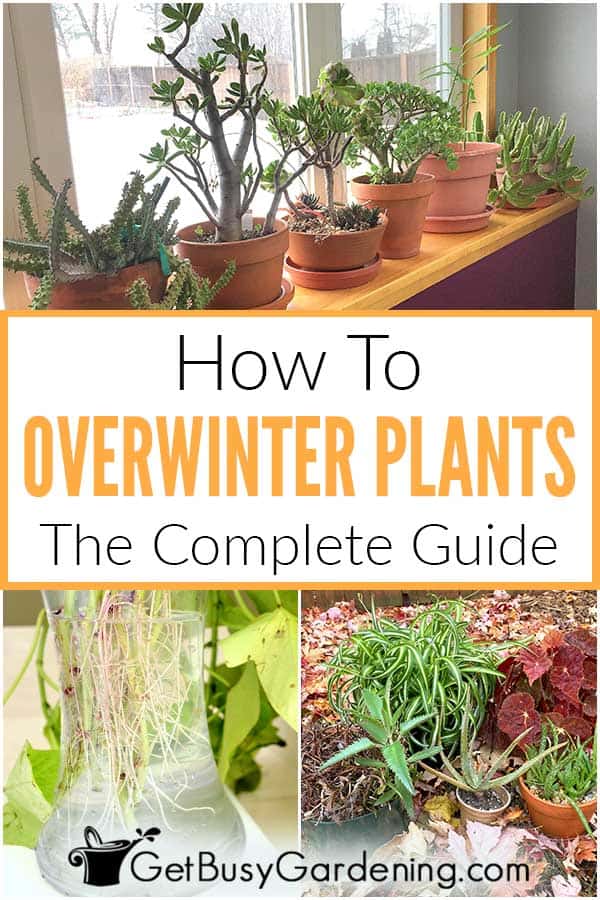
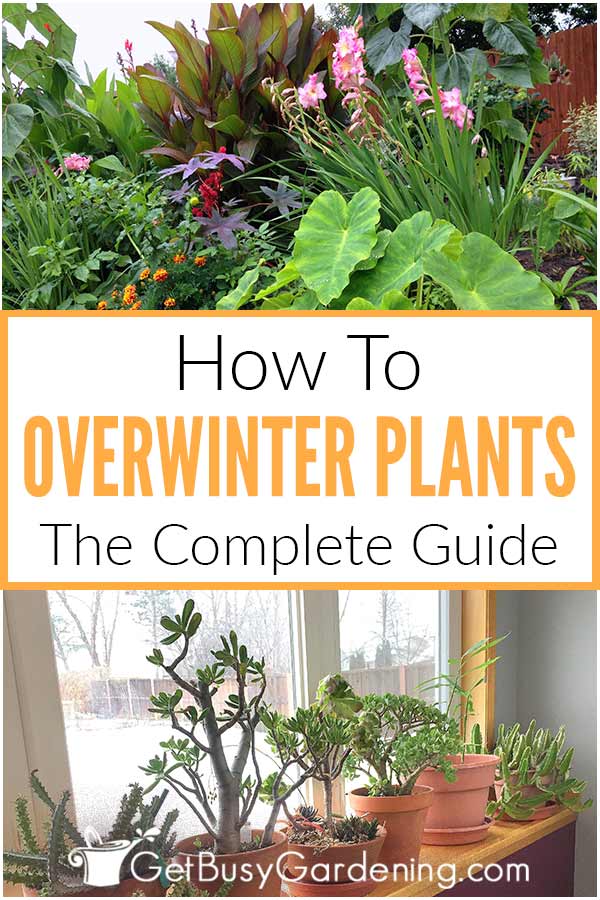
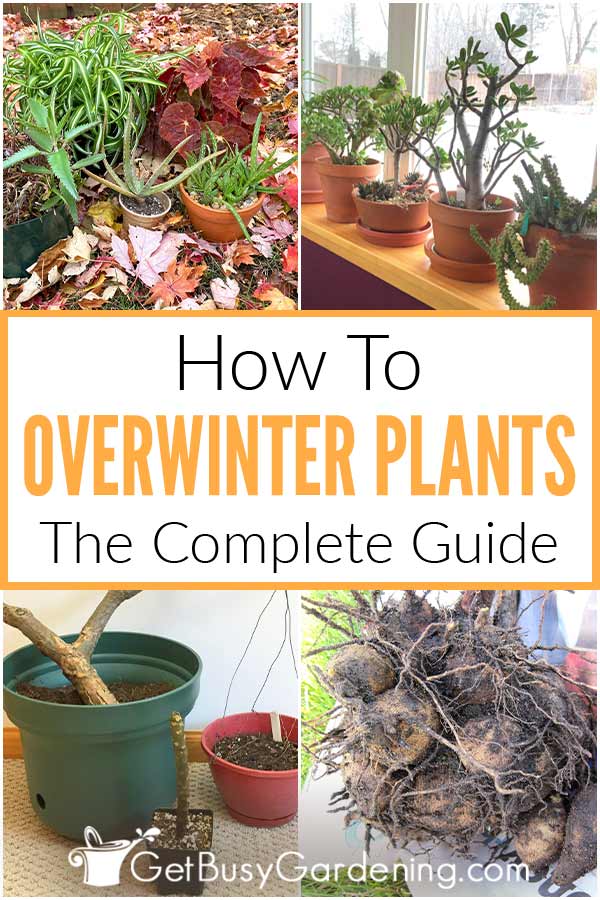



Kathy says
Hi Amy, Thank you for all the information. When I bring in my plants, sometimes they have little plant flies. How can I prevent this? Thank you.
Amy Andrychowicz says
Yes, those are very common when overwintering plants. Here’s my guide for how to get rid of them (they’re called fungus gnats), and a tutorial for how to debug plants before moving them inside to help you out.
Julia Dyer says
Hi Amy! I would love your help with overwintering my potted perennials and my bulbs. I’ve learned that I can’t leave them outdoors because the ground freezes hard here in northwest Ohio. It made me so sad when my perennials didn’t come back this spring after being outdoors all winter. I don’t have a greenhouse or garage that I can use, but I do have a spare bedroom with two large windows.
These are what I’m looking to overwinter:
Gladiolus and iris bulbs
amaryllis bulbs
Rain lily bulbs
spider plant
Aloe Vera plant
Christmas cactus
Cardinal plant
Bee Balm
Salvia
Yarrow
Clematis
Giant Pink
Milkweed
Red Blanketflower
Can you help me please? I don’t want to lose my perennials again.
Amy Andrychowicz says
Oh my, that’s a lot of plants to cover, LOL! Here are my answers, hopefully I got them all…
– Gladiolus, Rain lily bulbs <-- overwinter the bulbs following these instructions
– amaryllis <-- here’s what to do with the bulb and how to get them to rebloom
– spider plant, aloe Vera, Christmas cactus <-- can all be overwintered as houseplants, click the links to learn how to care for each. - iris, Cardinal plant, Bee Balm, Salvia, Yarrow, Clematis, Milkweed, Red Blanketflower <-- should all be perennials in your zone, they all come back in my z4b garden in MN. - Giant Pink <-- not sure what plant you're referring to here.
Julia Dyer says
I looked it up and the plant is actually called Giant Pink Mandevilla. The confusion arose because its tag only says, “Giant Pink”
Mary Jane Rein says
Amy, I enjoy reading on your website.. I live in the Mpls area of MN. Can I winter my potted geraniums in my unheated garage? Would like to give it a try.
Thank you for your advice..
Amy Andrychowicz says
I’m afraid your unheated garage would be too cold for overwintering geraniums. The ideal temperature is 40-50F, so if it stays in that range, it would be fine. Otherwise, it gets colder than that, it’s better to keep them in an unheated basement or the coolest room of your house.
Selena says
Hi Amy!
I have several pots of roses, hydrangea, sakura and olive. I am wondering if I can overwinter them all in unheated garage, which is quite cold that it could get sometimes -20C in middle of winter. I am beginner so I am not sure how cold would be considered as ‘extremely cold’?
Thanks for your interested topic!
Amy Andrychowicz says
I’m not sure what a sakura is, but you can definitely overwinter the hydrangea in your garage. For the roses, it depends on how hardy they are. You could overwinter the cold hardy varieties (ones that can handle temps below 0F). But I would definitely check to make sure the type you have can take the cold. Unfortunately, the olive tree won’t survive if it gets down below freezing, so I would try overwintering that one in the house instead. By “extreme cold”, I mean anything below zero fahrenheit (so I guess that would be about -17 for you?).
Amita says
Hello Amy,
I was looking for a good gardening blog and after going through some others chanced upon yours. I have been binge reading your blog since last few days….thank you for providing so much helpful information…it’s really helping me learn the essential gardening skills.
I read your post on winterizing tropical plants and am really excited to venture into these. I live in zone 6b and have avoided tropicals so far but am going to buy a few now. I also love gardenias and jasmine. Have you winterzed them and is it easy? What other tropicals would you recommend that aren’t too difficult to care for? Please let me know your thoughts.
Thanks again for a wonderful blog..I look forward to learning more from you.
Best
Amita
Amy Andrychowicz says
Wow, that’s awesome! So glad to hear that you love the site! Jasmine and gardenias can be a bit difficult to winter indoors because the bugs love them. It’s definitely worth a try to keep those gorgeous plants year after year. But just make sure to check the leaves for bugs often.
As for your question about other tropical plants, here are a few articles that should answer that question for you…
How To Overwinter Tropical Bulbs
How To Grow Tropical Plants Indoors
Mary Mueller says
I live in WI with very cold winters. I have taken cuttings from various hydrangea plants which are mostly doing quite well. Since they are quite small yet I brought the pots into the house for the winter. I have them in a sunny window but WI winters are typically dark. Any thoughts on keeping these little guys alive until I can plant them outside in spring? Thank you!
Amy Andrychowicz says
Hydrangeas are difficult to keep as houseplants through the winter months. They do better when you allow them to have a cold period of dormancy, as in nature. So I would try overwintering it in an unheated garage or a cold area in an unfinished basement, and let it go naturally dormant. Read the sections above titled “Overwintering Perennials In Containers and “How do you overwinter potted perennials?” for more details.
Cindi says
I usually overwinter elephant ears by letting them die back, leave them in their pots and put them in the basement, them bring them into light in the spring. Will hibiscus overwinter this way. They are 5 feet tall so I don’t have room to put them in the living room. I grew them from seed this year but they didn’t bloom so I would like to save them to see if they bloom next year.
Amy Andrychowicz says
No unfortunately, you can’t use the same method with hibiscus plants. The reason that works for your EEs is because they have bulbs in the soil that go dormant.
Derek says
I’m a huge tropical plant lover also from zone4, so very excited to see this! I love elephant ear, caladium, cannas and callas, and also start them from bulbs inside.
I am curious about your watering and fertilizing routine? Any other tips from your experience?
Thank you for sharing and inspiring fellow gardeners
Amy Andrychowicz says
Awesome, glad to hear you found my post inspiring! ? Tropical bulbs like a rich soil that drains well, but holds moisture too. They aren’t super fussy though. I have sandy soil, and mix some compost into it every fall. If you have heavy clay soil, then you could amend it with compost and maybe even some sand to help with moisture retention and drainage (though my dad grows beautiful cannas every year, and he never does anything to amend his heavy clay soil). I don’t fertilize them through the summer, but you certainly could. Just make sure to plant them in the full sun.
Jennifer Patterson says
I have been wintering my tropicals in the house for ages. I have Canna lilies, EE, and Dahlia’s. I also have been successful in wintering amaryllis, I have one bulb that is about 8 years old now. I put it in the house in the winter, and in garden in the summer, every year it blooms twice. In the middle of the winter, and in fact it’s getting ready to bloom again in a week or so. And it has had babies, so now I have a number of them.
Amy Andrychowicz says
Oh wow, that is awesome!
Midge says
I love the idea of overwintering tropical plants! My husband moved here from Hawaii and I have been wondering how I could make a little garden for him to remind him of home. Thank you for sharing this!
Amy Andrychowicz says
Oh wow, Hawaii! Yes, overwintering your tropical plants sounds like the perfect solution to his home sickness! 🙂
JoAnne C. says
Is it possible to overwinter exotic grasses, like King Tut, Prince Tut, and Baby Tut? I live in Canada, with very cold winters. Thanks.
Amy Andrychowicz says
Yes, you could try overwintering them like you would a pond plant. I don’t have the exact instructions, but you’ll have to cut back all the foliage, and wrap them in plastic so they don’t dry out. Then store them in a cool, but above freezing location. Make sure it’s very cool, or they could mold or rot. Good luck!
Jackie Furlong says
Hi! I have a lime tree that I want to bring inside for the winter. Lime trees are root bound plants, so I should re-pot it before bringing it in? Since I also need to de-bug the plant, will this help in the respect so I only have to clean the leaves, not the soil?
Thank you for your help!
Amy Andrychowicz says
Yes, if it is root bound, I would put it into a larger pot before bringing it indoors, so it’s easier to keep consistently watered during the winter. Also, once it’s inside, keep a close eye on it for signs of pest infestations. I had a lemon tree once and it was a magnet for mealy bugs, aphids and spider mites. I suspect a lime tree would have the same issues. You might might want to see if you could overwinter it in a dormant state, just to make pest management easier.